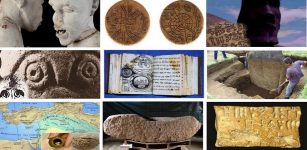Unsolved Mystery Of The Giant Footprints Outside The Ain Dara Temple
Ellen Lloyd - AncientPages.com - Outside the Ain Dara temple's entrance is a pair of giant footprints. It remains unknown who made them and why they were carved.
Our ancestors' conviction that superhuman beings gigantic in size once roamed the Earth is repeatedly reflected in ancient myths and legends.
Ain Dara, located northwest of Aleppo, Syria, an Iron Age Syro-Hittite temple. Image credit: Institute for the Study of the Ancient World Contact - CC BY 2.0
The once magnificent Ain Dara temple, or what's left, first attracted attention in 1955 when a monumental basalt lion was accidentally discovered.
If we travel to the village of Ain Dara, northwest of Aleppo, Syria, we come across an Iron-Age temple. The temple was later excavated between 1980 and 1985 and has often been compared to King Solomon's Temple.
As the Bible History Daily states, "the similarities between the 'Ain Dara temple and the temple described in the Bible are striking. Both buildings were erected on massive artificial platforms at the highest point in their respective cities.
The buildings likewise have similar tripartite plans: an entry porch supported by two columns, the main sanctuary hall (the hall of the 'Ain Dara temple is divided between an antechamber and the main chamber), and then, behind a partition, an elevated shrine, or Holy of Holies.
Colossal basalt lion found in 1955. (Ain Dara, Syria). Image credit: Materialscientist - CC BY 2.0
They were also both flanked on three of their sides by a series of multistoried rooms and chambers that served various functions."
However, although the Ain Dara temple shares many features with King Solomon's temple, it's unlikely it was the same building.
According to the excavator, Ali Abu Assaf, the Ain Dara temple existed for 550 years, from about 1300 BC. to 740 BC.
Archaeologists still cannot agree on the deity to whom the temple was dedicated. Some believe that it was dedicated to Ishtar, the goddess of fertility. Others suggest that it was the goddess Astarte, owner of the sanctuary. Yet, another group means it is likely that the temple holder was the god Baal Hadad.
The Ain Dara temple has several beautifully preserved structural features, including limestone foundations and blocks of basalt.
Reconstructed wall of Ain Dara Temple with cherubim relief in lower panel. Image credit: Odilia - CC BY-SA 3.0
Originally the building also had mudbrick covered with wood paneling, but today it's unfortunately lost.
The facade and interior walls are enlivened by hundreds of finely carved reliefs depicting lions, cherubim, mythical creatures, mountain gods, palmettes, and ornate geometric designs.
A pair of carved giant footprints are at the threshold of the entrance of the Ain Dara temple. They are about one meter long and face toward the temple's interior.
Like Solomon's Temple, the 'Ain Dara temple was approached by a courtyard paved with flagstones. The left footprint was carved on the flagstone, indicating that the god was entering the temple. The right impression was carved at the threshold to the cella, telling that the giant god needed only two steps to enter the temple.
Giant footprints outside the Ain Dara Temple. Credit: Verity Cridland - CC BY 2.0
The distance between the two single footprints is about 30 feet.
A stride of 30 feet would belong to a person (or goddess) about 65 feet tall. The temple is large enough for the god to enter and dwell in.
However, they were unlikely left by a being that entered the temple. The giant footprints remain an unsolved puzzle.
Scholars do not know why they were carved and what purpose they served. Some scientists have suggested that footprints can be designed to recall the presence of the gods, a sort of iconic representation of the deity. Although this is not a genuine pair of giant footprints, the carving is real, and it suggests our ancestors were familiar with and witnessed beings of gigantic size. Another possibility is that the huge footprints have a symbolic meaning.
Written by - Ellen Lloyd – AncientPages.com
Updated on April 2, 2023
Copyright © AncientPages.com All rights reserved. This material may not be published, broadcast, rewritten or redistributed in whole or part without the express written permission of AncientPages.com
More From Ancient Pages
-
 Exceptionally Long-Lived Ancient Form Of Hydraulic Engineering Unearthed In The Nile Valley
Archaeology | Jun 13, 2023
Exceptionally Long-Lived Ancient Form Of Hydraulic Engineering Unearthed In The Nile Valley
Archaeology | Jun 13, 2023 -
 Decoding Ancient Secrets Of Fascinating Virupaksha Temple
Archaeology | Nov 15, 2014
Decoding Ancient Secrets Of Fascinating Virupaksha Temple
Archaeology | Nov 15, 2014 -
 Why Were The 4,000-Year-Old Native American Shell Ring Villages Suddenly Abandoned?
Archaeology | Mar 3, 2022
Why Were The 4,000-Year-Old Native American Shell Ring Villages Suddenly Abandoned?
Archaeology | Mar 3, 2022 -
 Nakanishi Ruins: One Of Japan’s Largest Ruins Discovered In Nara
Civilizations | Aug 22, 2015
Nakanishi Ruins: One Of Japan’s Largest Ruins Discovered In Nara
Civilizations | Aug 22, 2015 -
 Sirius Mystery – Scientific Evidence Of Alien Contact 5,000 Years Ago – Book Review
Civilizations | Apr 1, 2014
Sirius Mystery – Scientific Evidence Of Alien Contact 5,000 Years Ago – Book Review
Civilizations | Apr 1, 2014 -
 South American Musical Instruments Reflect Population Relationships – Archaeological Records Reveal
Archaeology | Sep 20, 2021
South American Musical Instruments Reflect Population Relationships – Archaeological Records Reveal
Archaeology | Sep 20, 2021 -
 Native Americans And European Legends Tell Peculiar Beings From The Sky Still Live On The Earth
Ancient Mysteries | May 16, 2018
Native Americans And European Legends Tell Peculiar Beings From The Sky Still Live On The Earth
Ancient Mysteries | May 16, 2018 -
 Hawaiian Petroglyphs Reemerging On Oahu’s Coast Are Considered An Ancestral Message About Rising Ocean Levels
Archaeology | Jul 28, 2025
Hawaiian Petroglyphs Reemerging On Oahu’s Coast Are Considered An Ancestral Message About Rising Ocean Levels
Archaeology | Jul 28, 2025 -
 Legend Of The Sun And Moon In Cherokee Beliefs
Featured Stories | Jul 9, 2019
Legend Of The Sun And Moon In Cherokee Beliefs
Featured Stories | Jul 9, 2019 -
 Ancient Scandinavians Never Spoke Of Themselves As Vikings – Here Is Why
Ancient History Facts | Mar 15, 2021
Ancient Scandinavians Never Spoke Of Themselves As Vikings – Here Is Why
Ancient History Facts | Mar 15, 2021 -
 Egypt’s Dendera Temple: Second Restoration Phase Is Now Completed
Archaeology | Mar 6, 2021
Egypt’s Dendera Temple: Second Restoration Phase Is Now Completed
Archaeology | Mar 6, 2021 -
 Ancient Chinese Ball Game Cuju Is Earliest Form Of Football
Ancient History Facts | Jan 22, 2016
Ancient Chinese Ball Game Cuju Is Earliest Form Of Football
Ancient History Facts | Jan 22, 2016 -
 10 Mysterious Undeciphered Ancient Scripts, Tablets, Codes And Maps
Artifacts | Sep 16, 2014
10 Mysterious Undeciphered Ancient Scripts, Tablets, Codes And Maps
Artifacts | Sep 16, 2014 -
 Three 17th Century Shipwrecks Discovered In Central Gothenburg, Sweden
Archaeology | Oct 8, 2019
Three 17th Century Shipwrecks Discovered In Central Gothenburg, Sweden
Archaeology | Oct 8, 2019 -
 Nicholas Roerich’s Search For Shambhala And Wish To Fulfill The Mysterious Buddhist Prophecy
Ancient Mysteries | Nov 4, 2016
Nicholas Roerich’s Search For Shambhala And Wish To Fulfill The Mysterious Buddhist Prophecy
Ancient Mysteries | Nov 4, 2016 -
 Few Witches Were Executed In Wales In The Middle Ages – Why?
Featured Stories | Oct 29, 2024
Few Witches Were Executed In Wales In The Middle Ages – Why?
Featured Stories | Oct 29, 2024 -
 Old Babylonian Residential Building In Ur Dated To 1835 BC – Investigated
Archaeology | Jul 24, 2019
Old Babylonian Residential Building In Ur Dated To 1835 BC – Investigated
Archaeology | Jul 24, 2019 -
 On This Day In History: Battle Of King’s Mountain Was Fought – On Oct 7, 1780
News | Oct 7, 2016
On This Day In History: Battle Of King’s Mountain Was Fought – On Oct 7, 1780
News | Oct 7, 2016 -
 Freemasons Secrets – American Democracy Is Part Of An Ancient Universal Plan – Egyptian Temple And Legendary Expedition Hold The Clues – Part 2
Ancient Mysteries | Jul 13, 2018
Freemasons Secrets – American Democracy Is Part Of An Ancient Universal Plan – Egyptian Temple And Legendary Expedition Hold The Clues – Part 2
Ancient Mysteries | Jul 13, 2018 -
 Thousand year old Pagan warrior tomb discovered in Poland
News | Aug 23, 2015
Thousand year old Pagan warrior tomb discovered in Poland
News | Aug 23, 2015




